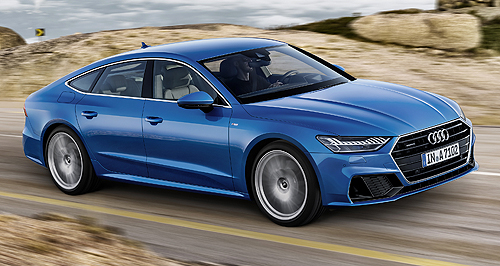Future models - Audi - A7 - SportbackAudi uncovers second-gen A7Seventh heaven: The new Audi A7’s design is similar to the new A8, with a radical LED matrix headlight and tail-light cluster design. All-new Audi A7 brings fresh design, new tech ahead of mid-2018 Australian debut20 Oct 2017 AUDI has lifted the lid on its second-generation A7 liftback, revealing a new design language previewed by the recently-revealed A8 sedan, ahead of an arrival in Australian showrooms by mid next year. At the front, the headlight design has been simplified with a squarer look that meshes with the front grille, however the technology going into the lighting signature has evolved. The headlights will be available in three versions – LED, HD matrix LED and HD matrix LED with laser high beam. Both HD matrix versions feature a distinctive vertically striped layout taking up the top half of the headlight cluster, which is split in half by the vertical daytime running light. The bottom half houses other lighting functions such as the cornering and turning lights. At the rear, tail-light design has been radically updated, with a long, vertical strip joining both tail-lights, which are made up of 13 vertical segments each. Exterior design borrows from both the A8 and new A5 with its contoured bonnet, however the coupe-sedan profile of the new A7 remains faithful to that of the original, which first arrived in Australia in 2011. Audi has used a new design process for the A7, which involves combining state-of-the-art computer-aided design (CAD) and 3D visualisation with traditional hand-crafted clay modelling, enhancing design accuracy. Dimensions have remained similar thanks to its Volkswagen Group MLBEvo platform, with an identical length to the outgoing model, while width and height have shrunk by 3mm and 2mm respectively. Front and rear overhangs have been reduced, with wheelbase length increasing by 12mm. Interior length has increased by 21mm leading to greater rear legroom, while loading width has also grown. Wheel choices up to 21-inches are available, as are four different suspension settings, ranging from conventional steel springs to self-levelling adaptive air suspension. The amount chrome on the exterior has been reduced in the new model, which will be offered in 15 different colours, including new hues of green, blue, red, grey and brown. An integrated lip spoiler returns for the second-gen A7 which extends automatically from 119km/h. Inside, the A7 gets the twin haptic touchscreen centre console displays from the new A8, reducing the number of buttons in the cabin. Measuring 10.1-inches and 8.6-inches respectively, the upper and lower screens control the infotainment system and climate control system. An optional 12.3-inch digital instrument cluster adds to the clean layout, while trim levels can be optioned with multiple colours, upholstery materials and trims. Four sound systems will be available, including a top-spec Bang & Olufsen unit. Thirty nine driver assistance systems are available across three packages, however it remains to be seen if all systems will be available in Australia, given the contentious legality of some advanced assistance systems. One such autonomous feature is the Audi AI remote parking pilot, which lets drivers manoeuvre their vehicle in and out of narrow parking spaces remotely. Powertrain options have not been detailed in full, but Australia is set to get a mix of four- and six-cylinder petrol and diesel engines at launch, including a 250kW/500Nm 3.0 TFSI V6 petrol unit. The 3.0-litre V6, which will be known as the 55 TFSI under Audi’s new naming conventions, will be teamed to a seven-speed dual-clutch automatic transmission, and will complete the zero to 100km/h sprint in 5.3 seconds. Audi’s new mild hybrid system for V6 variants uses a 48V electrical system detailed on the new A8 and it includes a coasting function, regenerative braking and reductions in fuel use by up to 0.7 litres per 100km. It will not be making it to Australia. Drive will come via both the front wheels and Audi’s quattro all-wheel-drive set-up, which will employ the new, fuel-saving Quattro Ultra system. The A7 will feature all-wheel steering, which can turn the rear wheels up to five degrees, reducing the turning circle at low sleeps and increasing stability at high speeds. Further down the track the line-up will likely be bolstered by a V8-powered S variant, while a range-topping RS model is also a given. The A7 is expected to make its public debut at the LA auto show in December. More details on the A7’s Australian specification and pricing will become available closer to the model’s launch.  Read more24th of August 2017  Audi to change model naming conventionsNew Audi nomenclature prioritises power over displacement12th of July 2017  Audi A8 debuts autonomous tech, but not for AusTech-fest A8 throws gauntlet down to rivals as glimpse of Audi futureA7 pricing
Motor industry news |
Click to shareAudi modelsResearch Audi A7 pricing
Motor industry news |












































Facebook Twitter Instagram